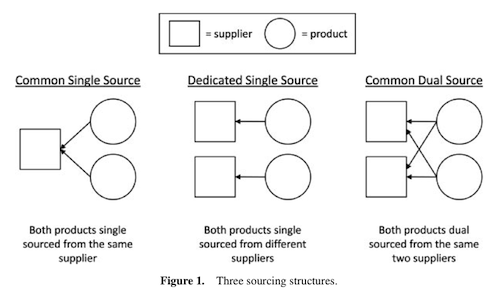Disruption-Management Strategies for Short Life-Cycle Products
In his 2009 paper Brian Tomlin analyzes strategies to mitigate disruption risks in a three echelon supply chain.
Setting
Focus in his research is a single company, with its suppliers and customers. The objective is to maximize expected utility, while demand and supply are uncertain. There are two products available which can be used as substitutes. The time horizon for the decision maker is one season where the products can be sold.
Three different sourcing structures are considered.

Variables / Attributes of the SC
The following attributes in the supply chain are used as free variables and can therefore be modified:
- Suppliers
- Supplier reliability
- Correlation between supplier failures
- Proportion of order cost charged in the event of a failure
- Relative cost of emergency supplier
- Products
- Contribution margin
- Demand uncertainty
- Demand correlation
- Substitutability
- Firm
- Risk aversion of the decision maker
Strategies
The effects of three major adaption strategies on the risk exposure / expected profit are tested:
- Supplier diversification
adding another supplier to lower the overall risk for failure - Contingent sourcing
adding a supplier which is only used in case the main supplier fails to deliver - Demand switching
shifting customer demand to a different product
There is also the possibility not to engage in any activity and accept the risks.
Results
It is shown that contingent sourcing is the preferred strategy to supplier diversification for the firm, if the failure probability of the supplier increases. Furthermore, demand switching is an effective strategy for controlling demand risk and therefore is the preferred strategy with low supply risk.
Higher levels of risk aversion lead to a preference for contingent sourcing over the other strategies.
Conclusion
Tomlin shows viable and effective strategies to increase profit (utility) in supply chain settings with disruption risk. He therefore calculates the expected profits in different situations and uses the results to give suggestion for situational optimal strategies to mitigate these risks.
Tomlin, B. (2009). Disruption-management strategies for short life-cycle products Naval Research Logistics, 56 (4), 318-347 DOI: 10.1002/nav.20344








Add new comment